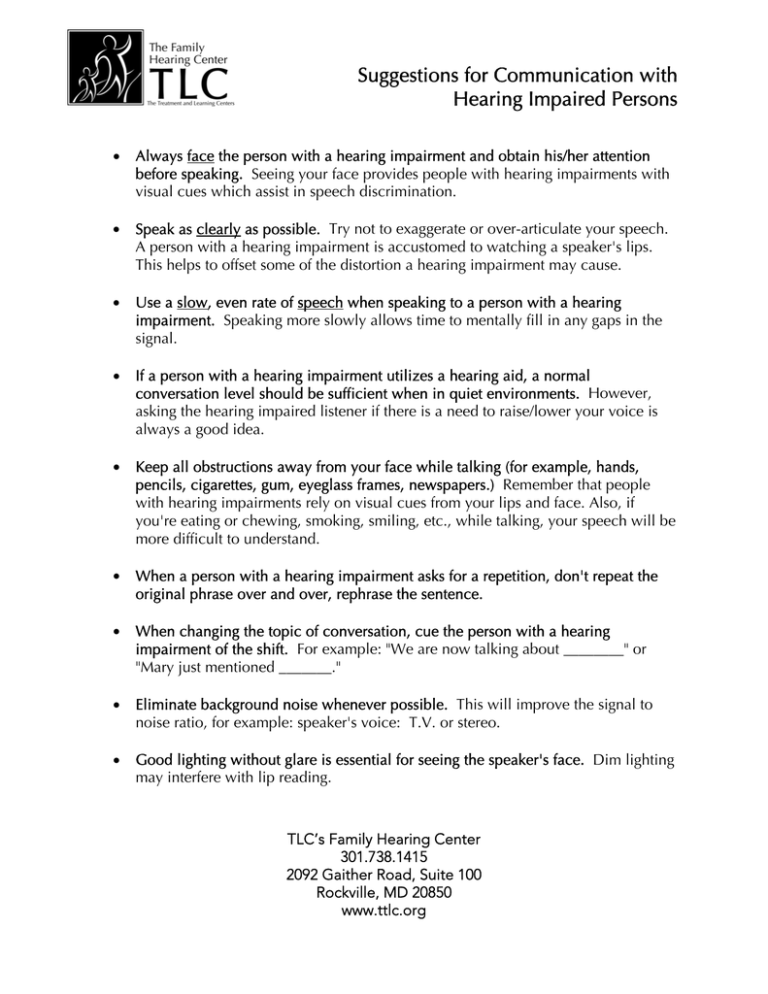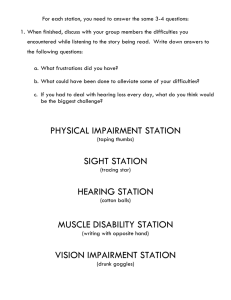Suggestions for Communication with Hearing Impaired Persons
advertisement

Suggestions for Communication with Hearing Impaired Persons Always face the person with a hearing impairment and obtain his/her attention before speaking. Seeing your face provides people with hearing impairments with visual cues which assist in speech discrimination. Speak as clearly as possible. Try not to exaggerate or over-articulate your speech. A person with a hearing impairment is accustomed to watching a speaker's lips. This helps to offset some of the distortion a hearing impairment may cause. Use a slow, even rate of speech when speaking to a person with a hearing impairment. Speaking more slowly allows time to mentally fill in any gaps in the signal. If a person with a hearing impairment utilizes a hearing aid, a normal conversation level should be sufficient when in quiet environments. However, asking the hearing impaired listener if there is a need to raise/lower your voice is always a good idea. Keep all obstructions away from your face while talking (for example, hands, pencils, cigarettes, gum, eyeglass frames, newspapers.) Remember that people with hearing impairments rely on visual cues from your lips and face. Also, if you're eating or chewing, smoking, smiling, etc., while talking, your speech will be more difficult to understand. When a person with a hearing impairment asks for a repetition, don't repeat the original phrase over and over, rephrase the sentence. When changing the topic of conversation, cue the person with a hearing impairment of the shift. For example: "We are now talking about ________" or "Mary just mentioned _______." Eliminate background noise whenever possible. This will improve the signal to noise ratio, for example: speaker's voice: T.V. or stereo. Good lighting without glare is essential for seeing the speaker's face. Dim lighting may interfere with lip reading. TLC’s Family Hearing Center 301.738.1415 2092 Gaither Road, Suite 100 Rockville, MD 20850 www.ttlc.org Suggestions for Communication with Hearing Impaired Persons (continues) (continued) At a dining table, no centerpiece should be allowed to obstruct the person's field of vision. When dining out, call ahead and make reservations or ask to be seated in a quiet corner away from the kitchen, busing stations and traffic. In a car/restaurant/outside, encourage the person with a hearing impairment to position himself/herself with the better ear/hearing aid directed towards the speaker. When going to the theater/church/synagogue, plan in advance so that the person with a hearing impairment can see and hear as well as possible. Help the person investigate various seating arrangements to find allowing him/her to both see and hear well. Arrive early enough to allow for seating in one of these areas. Check to see if the theater/church/synagogue has an infrared system or any type of assistive device for hearing help. Don't try to communicate from a different or distant room. Only initiate conversation when you are face-to-face and have elicited the person's attention. TLC’s Family Hearing Center 301.738.1415 2092 Gaither Road, Suite 100 Rockville, MD 20850 www.ttlc.org
